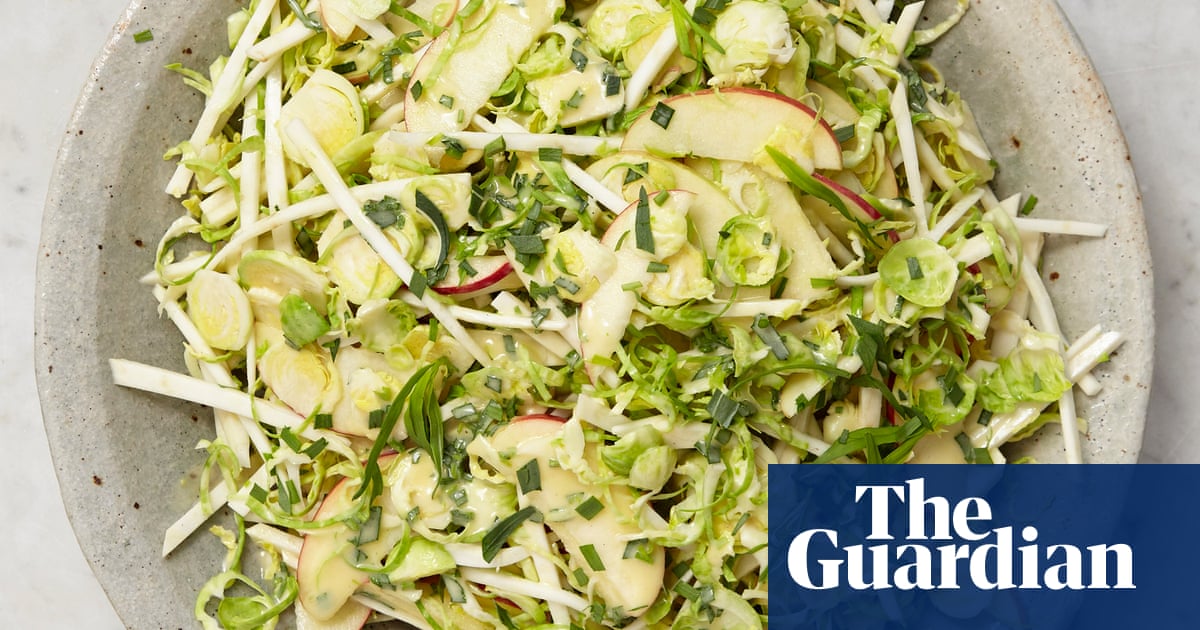What’s the trick to great coleslaw?Chris, Paignton, Devon“Coleslaw is such an under-rated salad,” says the Guardian’s Felicity Cloake, whose latest book,Peach Street to Lobster Lane, was published last week. “Familiarity breeds contempt.” (As do those claggy tubs you get in supermarkets.) The whole point of coleslaw is that the veg has to be crisp, which is why Cloake shreds rather than grates the cabbage (a mandoline or food processor is helpful here). “That will leave it less mushy. And, if you have the patience, shred the carrot, too.” Cloake tosses the two with salt, vinegar and a little sugar, then leaves the mix to sit: “This both softens and seasons it.” Then, once drained, bring on the mayo: “Don’t go overboard, though – it should be lightly dressed rather than gloopy.”
Conveniently, Jessica Prescott, author ofEpic Salads: For Every Mood, Craving and Occasion, has been working on an essential coleslaw guide, and her dressing template goes like this: “Two tablespoons of something creamy [mayo, sour cream, yoghurt], a tablespoon of something acidic [lemon or lime juice, apple cider vinegar], and citrus zest, if you like. A spoonful of mustard, honey or soy sauce can deepen the flavour.”
If mayo is your “something creamy”, Richard Turner, chef/partner ofBodean’s, advises adding some soured cream or creme fraiche, too, though Jack Croft, chef/co-owner ofFallow,FowlandRoe, all in London, would ditch the white stuff altogether. He favours dijon mustard, a splash of good-quality vinegar, a drizzle of olive oil and a load of fresh herbs (chives, parsley): “That’ll be rich enough without feeling heavy.” Cloake often adds horseradish or mustard, plus finely chopped spring onion or chives.
Another good tip for counteracting coleslaw that cloys comes from the queen of country herself,Dolly Parton. In her bookDollyWood Presents Tennessee Mountain Home Cooking, she combines dill pickle brine with mayo, white vinegar and seasoning (and adds a minced pickle to the slaw, too).
Whatever your poison, it’s then time to prep the veg, Prescott says: “Thinly slice a quarter of a small green, red, savoy or napa cabbage, soak in cold water, then spin dry for maximum crunch.” You could bolster things with grilled corn (“my absolute favourite”), carrot or cucumber: “Grated, finely diced or thinly sliced all work, but if you’re adding water-heavy veg, sprinkle with salt and let them sit first.” Soft herbs, “finely chopped so they integrate rather than dominate”, are non-negotiable, too, as is setting the lot aside for 15 minutes, so “the flavours get friendly”.
Once dressed, “taste, taste, taste”, Turner says, because “a slaw’s character changes over time”. And if you’re not eating it straight away, Croft advises to cover and chill. “Just before serving, season with salt and a good squeeze of lemon – this keeps the slaw fresh, bright and avoids clagginess.”
There is, of course, a whole world of slaws beyond coleslaw. Start by mixing up the veg: Turner combines a shredded savoy, two finely sliced onions, a julienned granny smith, a thinly sliced green pepper, a jalapeño and chopped coriander and mint. “Mix 100ml yoghurt, the juice and grated zest of two limes, some salt and sugar, and pour over the vegetables,” says Turner, who chills until ready to serve.
“I make one with ribboned mango tossed with sliced red onion, chilli and coriander,” adds Maria Bradford,food writerand chef/owner ofShwen Shwenin Sevenoaks, Kent, who brings that together with a lime and maple dressing. “It’s delicious with grilled meat or a whole baked bass or snapper.” The real takeaway here is that slaws are “one of the most flexible dishes around”, Prescott says, so do your worst: “They’re riffable and always satisfying.”
Got a culinary dilemma? Emailfeast@theguardian.com
